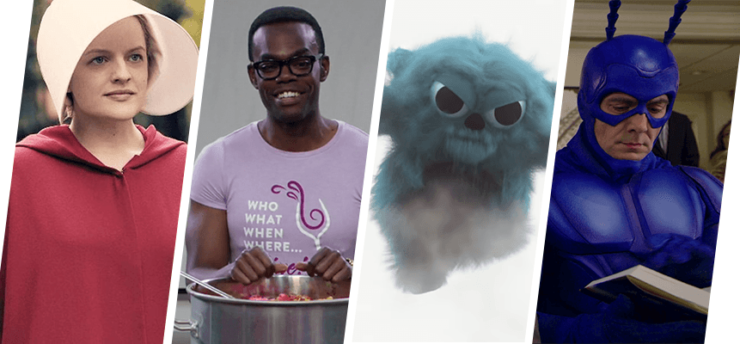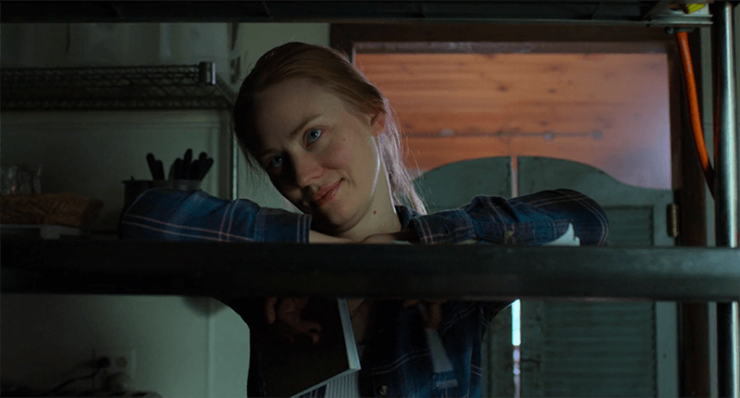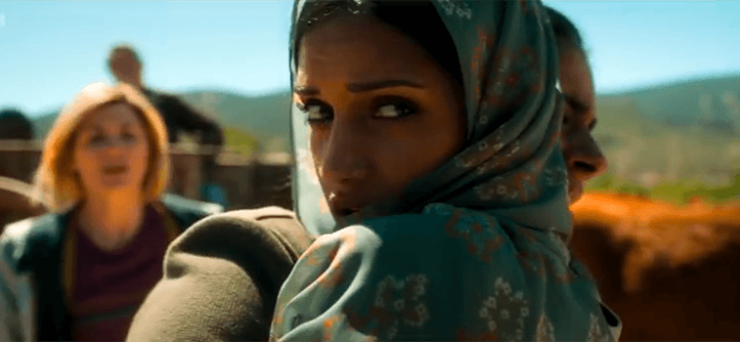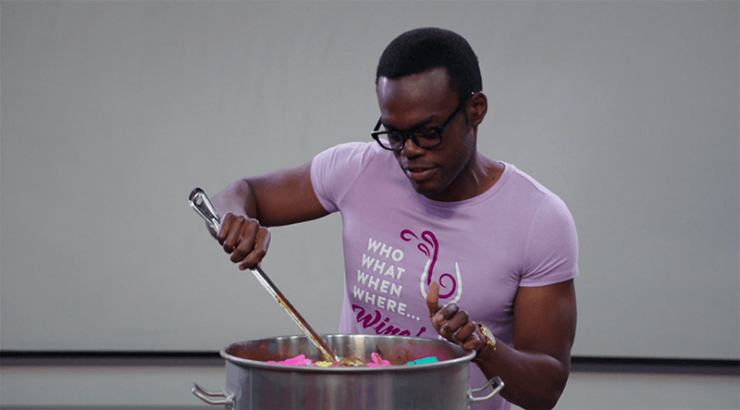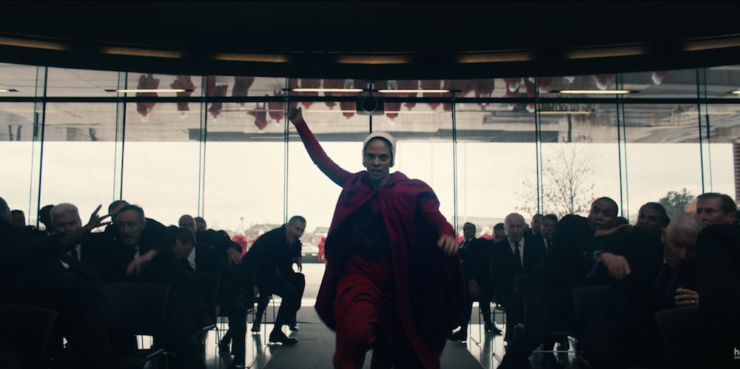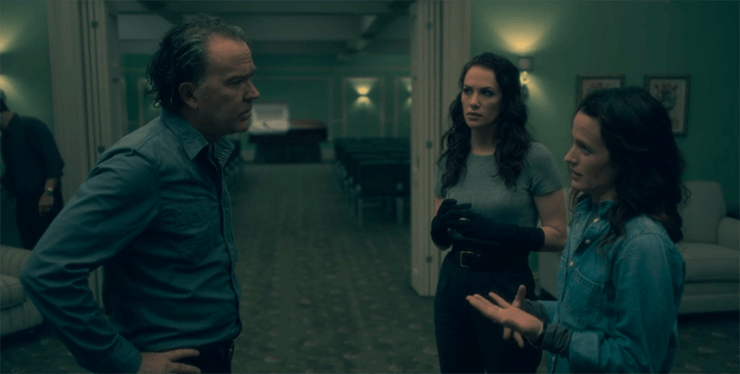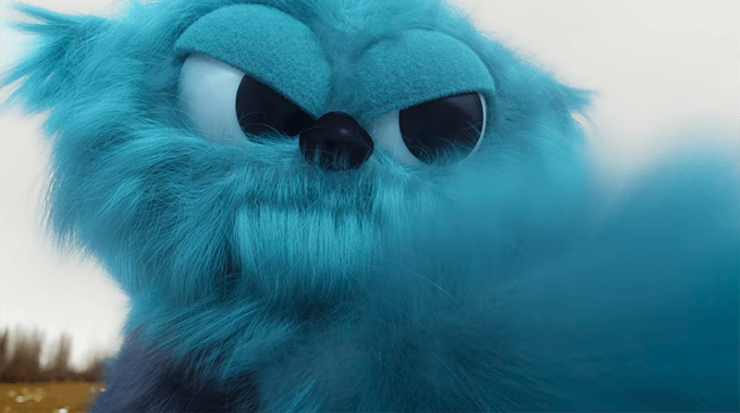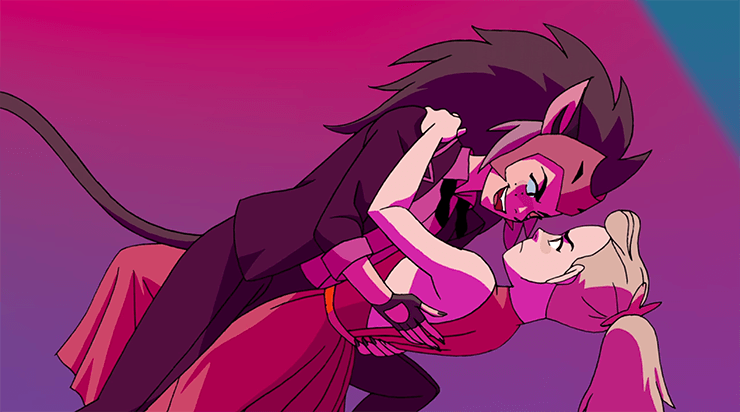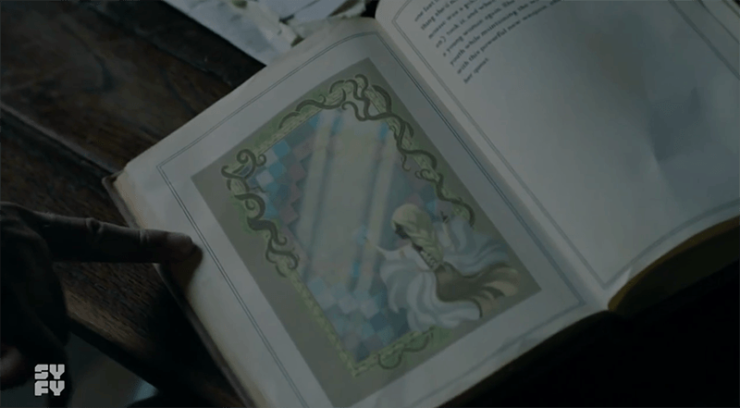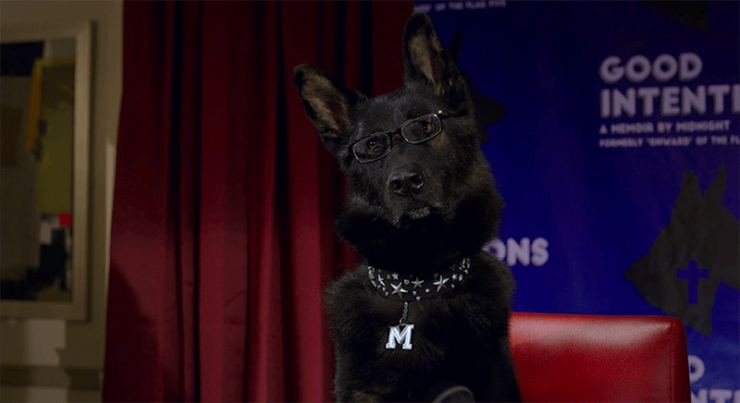Cannibalism, cuddly creatures, alternate timelines, flashbacks, and one big vat of Peeps-flavored chili: this year’s SFF television shows had a lot to give. Rather than listing our favorite series, this year we’ve opted to pick our ten favorite single episodes of SFF TV. From Doctor Who’s trip to one companion’s family history to Legends of Tomorrow’s big blue battle monster, these are the episodes we watched and rewatched and came to work talking about.
Which were your favorites?
“The Dark Year,” The 100
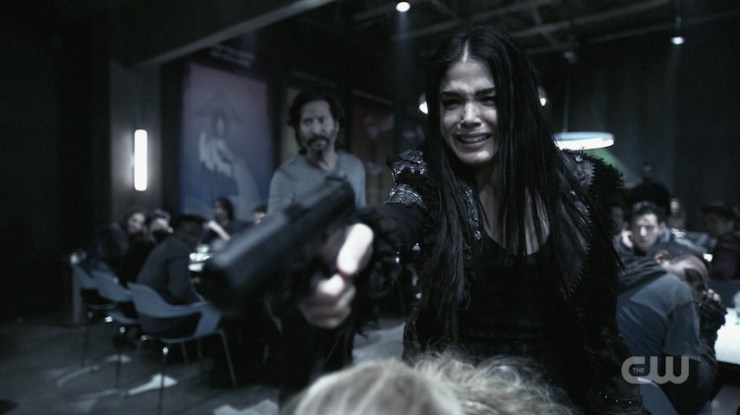
It’s the rare TV series that can make cannibalism boring, but The 100 managed it. Or, if not boring, then anticlimactic—all season, as the Wonkru survivors whispered about “doing what they needed to survive” in the bunker and solving all their issues in trial by combat, it seemed pretty clear what they did with the bodies after the fight was over. So by the time Abby starts tremulously revealing the events of “the dark year,” they surprised no one.
Except… it’s one thing to guess cannibalism as a plot twist, and another to watch these poor people—who have already been through so much with Skaikru vs. Grounders, Mount Weather, the City of Light, and Praimfaya—staring down at the jiggling gelatinous cubes that used to be their friends and family. Watching them force down this taboo nourishment is actually stomach-turning, but it’s not even the most memorable part of the episode.
All season, we’ve witnessed the Octavia of six years in the bunker: the Red Queen, or Blodreina, intoning her unintentionally comical “You are Wonkru, or you are the enemy of Wonkru. Choose.” But in “The Dark Year,” we see what pushed her to take on that role—holding a gun to her kru members’ heads and forcing them to engage in cannibalism, or else they choose to join the growing pile of bodies. Watching Octavia beg dissenting members not to force her into this role, then sob as she gunned them down for not aligning with Wonkru, was heartbreaking. The fact that this show can get so bonkers yet still retain a solid emotional foundation is incredibly impressive. —Natalie
“Karen,” Daredevil
“Karen” is harrowing, but it manages the neat trick of paying off two seasons of hints about Karen Page’s early life while also standing as a solid hour of TV on its own. The writers give us a chilling portrait of the small, judgey town that Karen longed to escape, and show us how she got her steel rebar moral core—and also why she can knock back whiskey like it’s ginger ale. But with this episode we also get a look at an utterly normal person in a world of superheroes.
Karen doesn’t have super abilities, or Columbia Law School money, or even a loving family. She builds herself back up after a terrible loss, changes careers, learns how to trust people, becomes a loyal friend—and she does it all without super strength or heightened senses. Even the color scheme changes, as the shift to wintry Vermont allows the story to be told through muted blues and greys, which is all the more shocking when we come to the terrifying red-lit superhero battle that closes the episode. But even here, it’s Karen who gets the bravest moments of all … but I don’t want to spoil that. —Leah
“Demons of the Punjab,” Doctor Who
Doctor Who told so many beautiful stories in Thirteen’s first season, but “Demons of the Punjab” really set a new bar for what the show could accomplish when digging into history. Written by Vinay Patel, this episode centered around the partition of India, made more personal for the Doctor and friends because Yaz’s grandmother Umbreen was present when it happened. There is plenty of mystery to the tale—Umbreen’s wedding to a man who is not Yaz’s grandfather, a strange alien presence, the question of whether or not history is unfolding properly—but when it all comes together, this is ultimately a story about family. A story about losing the people we love to extreme ideologies. A story about the long-standing impact of colonialism, even once it withdraws. A story about the histories that travel with us, and how they make up our present and future.
While plenty of historical episodes on Doctor Who wind up wobbly on the actual history front, this tale is meticulously researched, beautifully acted, and deeply personal. It appears to be a simple, straightforward narrative that proves much bigger on the inside… just like the TARDIS itself. Episodes like this prove that even after fifty-five years, Doctor Who is a series that continues to evolve, and still has plenty more to offer its fans. —Emily
“Jeremy Bearimy,” The Good Place
Look, the world is rough, the planet might collapse in on itself, and sometimes it truly feels like our current timeline has nothing left in it but pain, suffering, and destruction. And that’s where The Good Place miraculously swoops in and somehow makes existence seem more manageable. This season, we were gifted with “Jeremy Bearimy,” an episode that sees Michael and Janet finally explain the Good Place and the Bad Place and the universal point system to their little crew. Philosophy professor Chidi takes poorly to this, goes on a shopping spree, gives his car to a stranger, makes a vat of M&M and marshmallow Peep-filled chili, and proceeds to share what he has learned with his ethics class. He briefly outlines three distinct schools of philosophy—virtue ethics, consequentialism, and deontology—and what they have to say about living an ethical life. Then he proceeds to tell them that none of these concepts matter because everything is garbage, and the only proper course to follow is nihilism. “The world is empty,” he hisses at his students. “There is no point to anything, and you’re just gonna die. So do whatever!” Despite their questions about the upcoming exam, he is unmoved, and tells them to leave him in peace to eat his mortifying chili-candy stew.
The day that I watched this scene, my brain was in precisely the same place that Chidi’s was, and watching him fall apart like that (though the trappings of his breakdown were still hilarious) brought me to tears. The show had managed to shine a laser pointer at the most vulnerable part of my brain, and I wondered: If Chidi couldn’t pick himself up from this, as a person who has ordered is life around ethical thinking, then how could I possibly manage? But Eleanor is there, in Chidi’s classroom. And she tells him that she went through her own weird little crucible that day, and came to a different conclusion. She suggests that their group spend the remainder of their time aiding as many people as they possibly can in getting to the Good Place. That if they can’t help themselves, the least they can do is help the rest of these poor idiots bound to the Earth with no idea of what’s coming after.
In a universe of infinite worry, strife, and terrible random happenstance, The Good Place only had one solution—take care of each other. Which was precisely what I needed to hear. —Emily
“First Blood,” The Handmaid’s Tale
The sophomore season of The Handmaid’s Tale, the first season to go off-book, was an emotional rollercoaster that more than once threatened to throw its viewers off. But for all the low lows, the highs were praise-hand-emoji-worthy. And while Elisabeth Moss gave tour de force performances all season, in everything from the quiet fury at Offred’s baby shower to the primal, screaming birth of June’s second child, my criteria for best episode of the season is more about the overall feel of an hour of television.
For me, the most memorable episodes are the ones that give you the greatest range of moments. And that’s where “First Blood” comes in. There’s the laugh-out-loud absurdity of a bunch of Handmaids reminiscing on the best place to get eggs Benedict in the pre-Gilead times. The chill of watching Serena Joy seduce undergrads with her right to speak, even if it’s the honeyed trap of becoming these indentured women bound by the usefulness of their wombs. The oh-shit-they-went-there wedding night moment with the sheet. But most of all, the ending.
As uplifting as Offred’s story is in the book, Margaret Atwood’s text doesn’t provide the same cathartic moments of radical revolution. Watching The Handmaid’s Tale in our current climate, which feels more and more like Serena Joy’s flashbacks every day, we needed to see a Handmaid run at a Commander with a bomb strapped to her chest. To see a Red Center exploded from the inside. First blood has already been drawn. Considering the violence we wake up to every morning, a little violence in our dystopian fiction can feel like the only way to push back. —Natalie
“Two Storms,” The Haunting of Hill House
Episode 6 of The Haunting of Hill House is called “Two Storms.” It’s a mundane title for one of the best, most intricate hours of television I’ve ever seen. The basic (non-spoiler) plot is this: the Crain family, whom we follow throughout the series, have reunited for a funeral. While they’re in the funeral home, a terrible thunderstorm breaks out. As the reunion goes from “tense” to “shouted recriminations,” thunder rolls, lightning flashes, and the power blips in and out. Woven into this present-day storyline are flashbacks to the Crains nearly twenty years earlier, while they’re still living in Hill House, during an even more violent storm. Both storms are creepy and yes, there are ghosts.
But of course this is only a hint of what’s going on. The show layers the timelines seamlessly, so a character will walk through a door in the funeral parlor and suddenly be themselves, twenty years earlier, walking into the kitchen at Hill House. We recognize the roots of the tensions between the adult Crain siblings in their younger selves, having those arguments for the first time. Maybe the most effective trick is when patriarch Hugh Crain walks into the funeral home for the first time, and he sees all of his children as children; the camera pans across his pained face, and by the time it swings around the kids are seen as the adults they are now. All of this is accomplished with slow, gorgeous tracking shots, perfectly constructed sets, and actors who were willing to pop up and roll out of the way with perfect timing to take us back and forth in time. Of course most of all the actors are uncannily perfect and moving. In the end this is the episode that acts as a distillation of the whole series: a horror show that’s really about family bonds, guilt, and love. —Leah
“The Good, the Bad, and the Cuddly,” Legends of Tomorrow
I can’t think of another time that I’ve been as rewarded for sticking by a show through its bumpy first season (maybe Buffy?). From season two on, Legends of Tomorrow has been the CW superhero show that breaks from the norm: it’s funny, it’s self-aware, it’s opened its arms to every absurd thing about heroes and time travel and future technology and the sheer piled-up ridiculousness of constantly having to save the world, or the timeline, or your friends, or whatever. And the third season finale is a perfect case in point: to defeat the demon Mallus, the team has to unite the totems they’ve spent the season collecting—then focus the totems’ combined power into one powerful being. Their first attempt goes horribly awry. Their second results in something that only this show could’ve pulled off: a giant goddamn Beebo that proceeds to bodyslam Mallus into history.
Sure, there are also pirates and Vikings and Blackbeard and a visit from Helen of Troy, whose story got rewritten when she was dropped off in Themyscira, but the giant Beebo is everything that makes this show tick. It’s self-referential, it’s hilarious, it’s a muddle of pop culture references that somehow works perfectly, and it’s a reminder that heroes are just like us: hapless dorks who can’t get random stuff out of their heads at the worst possible moments. Beebo is, indeed, our one true god. —Molly
“Princess Prom,” She-Ra and the Princesses of Power
She-Ra swooped in toward the end of the year and blew fans away—it’s frankly hard to pick a single episode that stood out because there are so many strong ones. “Princess Prom” edges them out for offering queer women a right-of-passage that they have often been denied, both in real life and in fiction: A prom. Not a summit, not a war room meeting, not a talent show, but an honest-to-goodness prom populated primarily by women who are all decked out precisely as they’d prefer to be. This episode features a banquet of presentations, drama, intrigue, and fantastic outfits. Catra wears a dapper suit and cutoff gloves (bowtie undone for the duration of the evening), Scorpia flaunts a figure-hugging vampy black dress with her close-cropped hair, Glimmer is all frills, Entrapta… basically just shows up in her normal clothes. Some of the women there are friends, and some of them are clearly dating. Catra flirts with Adora to heighten her suspicions; Glimmer and Bow are having a spat; Sea Hawk is just delighted that Mermista actually brought him along.
On top of all this, the episode does an incredible job at building the world, advancing the plot, and providing endless exchanges to laugh about. Forget John Hughes movies, forget every sitcom prom episode, forget the weird school dance at the end of Stranger Things season two. None of them come close to the what it felt like watching Adora being dipped in an evening gown by her former-best-friend-turned-nemesis. “Princess Prom” is everything. —Emily
“A Life in the Day,” The Magicians
A lot happens in this episode—so much that I’d forgotten it was relatively early in the show’s stellar third season. Thanks to the fairy queen, High Queen Margo is suddenly betrothed—god, it’s annoying being royalty, all these tactical proposals—to a fellow accurately referred to as a walking jawline. Penny is stuck in the astral plane, which freaks Kady right out when Alice (who is not quite herself) brings spectral-Penny to see her in rehab. Julia has magic, and finds out why from Our Lady Underground.
But all of these semi-hectic, totally stressful plots swirl around Quentin and Eliot’s story, which does something entirely unexpected: it ends. On a quest to find the next key, they travel to Fillory to work on a certain magical mosaic: make a picture depicting the beauty of all life, and they key is yours. Things go wrong right from the start: they land in Fillory not in the present, but some time in the past. On the plus side, magic works. On the downside, the mosaic is impossible. They graph, they plot, they plan … and they live. In a series of magical scenes, many of them wordless, Q and Eliot work on their task, and they build a life together. Q marries a woman and has a child, and their family includes Eliot, who holds Quentin when Arielle dies, and stands proudly by Q’s side as they send the boy out into the world. They age, they work, they keep going, and when Eliot dies, it’s quietly, impossibly heartbreaking—and all the more so when Quentin, digging a grave, finds a sparkling tile.
The answer to the mosiac was never an image. There is no solution; there’s only life. And because there’s magic, there’s salvation, and a timeloop, and Margo, dirty and heartbroken, saving the two of them before they even start this mad, beautiful, other life. The Magicians is at its strongest when it’s not shy about how much these characters love each other, and how many different forms that love can take. This episode overflows with heart. —Molly
“After Midnight,” The Tick
It’s nigh impossible to choose a single best episode of The Tick, first because they’re all so good, but also because the arc of this first season was so tight that untangling one episode from the whole almost feels like walking through the sand of a perfectly proportioned mandala.
But I’m gonna do it anyway.
“After Midnight” comes early in the second half of season one. Arthur has put most of the pieces together in The Terror’s plan to murder Superian, but how can they warn him? After all, Superian is literally the most famous man on the planet, so a ground-level hero like The Tick can’t get anywhere near him. Luckily Arthur’s stepdad Walter is going to a book signing for Good Intentions, a self-help book written by Midnight, a superheroic talking dog/former member of the super-team the Flag Five. (Honestly I’m simplifying this as much as I can. I told you it was a mandala-esque mosaic.) So they can just turn up and warn him during the Q&A, right? Arthur soon learn that being the guy who has “more of a comment, really, than a question?” at a book event is courting extreme unpopularity. Slapstick antics ensue, and I honestly can’t even write anymore because now I’m laughing too hard to type.
Just go watch it already. Watch the whole season, it’s the best thing on TV. —Leah










